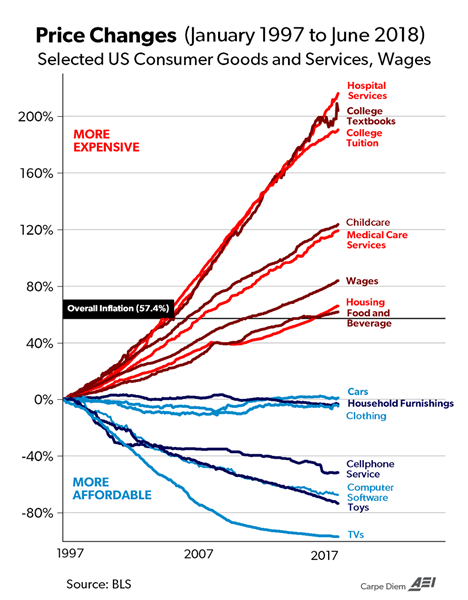And while a great deal of the focus will be the continued shift away from brick-and-mortar to digital, we can also use the time to acknowledge the best news: it is easier than ever to purchase common household goods.
Did you purchase a television on Black Friday? Today, TVs are universal, and if you don’t have one it is likely because you made the conscious decision not to have a TV in your house, not because you can’t afford it.
That’s because TVs, like most commonly owned goods, have declined dramatically in price. A 23” color TV in 1968 cost $2,544 (in 2018 dollars). Based on the average hourly wage in the manufacturing sector, also in today’s dollars, it would take 125 hours of labor to afford that purchase. Last week, 32” smart TVs were available for $99, or less than 5 hours of labor. And this doesn’t take into account the technological advances of TVs in 2019.
When we see stories about wages being stagnant or new generations being worse off than their parents, we miss one very important item: purchasing power. Yes, government regulated items like education and healthcare have increased much faster than inflation, yet that’s not true of most consumer goods, as shown in the chart below.

We have the ability to purchase more items, and we are likely buying items of greater than quality.
Need something else to be thankful for? The cost of your Thanksgiving dinner slightly declined from the past year, continuing a 30-year trend.
“The main course on many Thanksgiving tables, the turkey, costs slightly less than last year,” a new story from Human Progress found. “In 2019 the average nominal cost of a Thanksgiving turkey stands at $20.80 for a 16-pound bird. That’s roughly $1.30 per pound, a 4 percent decrease from last year. And that’s before adjusting for inflation!”

And if you traveled last week, you’ll also be happy to know that air travel continues to get safer.
Our well-being is improving, and it’s expanding to more and more Americans. Something we rarely hear about, or talk about. Maybe we should.